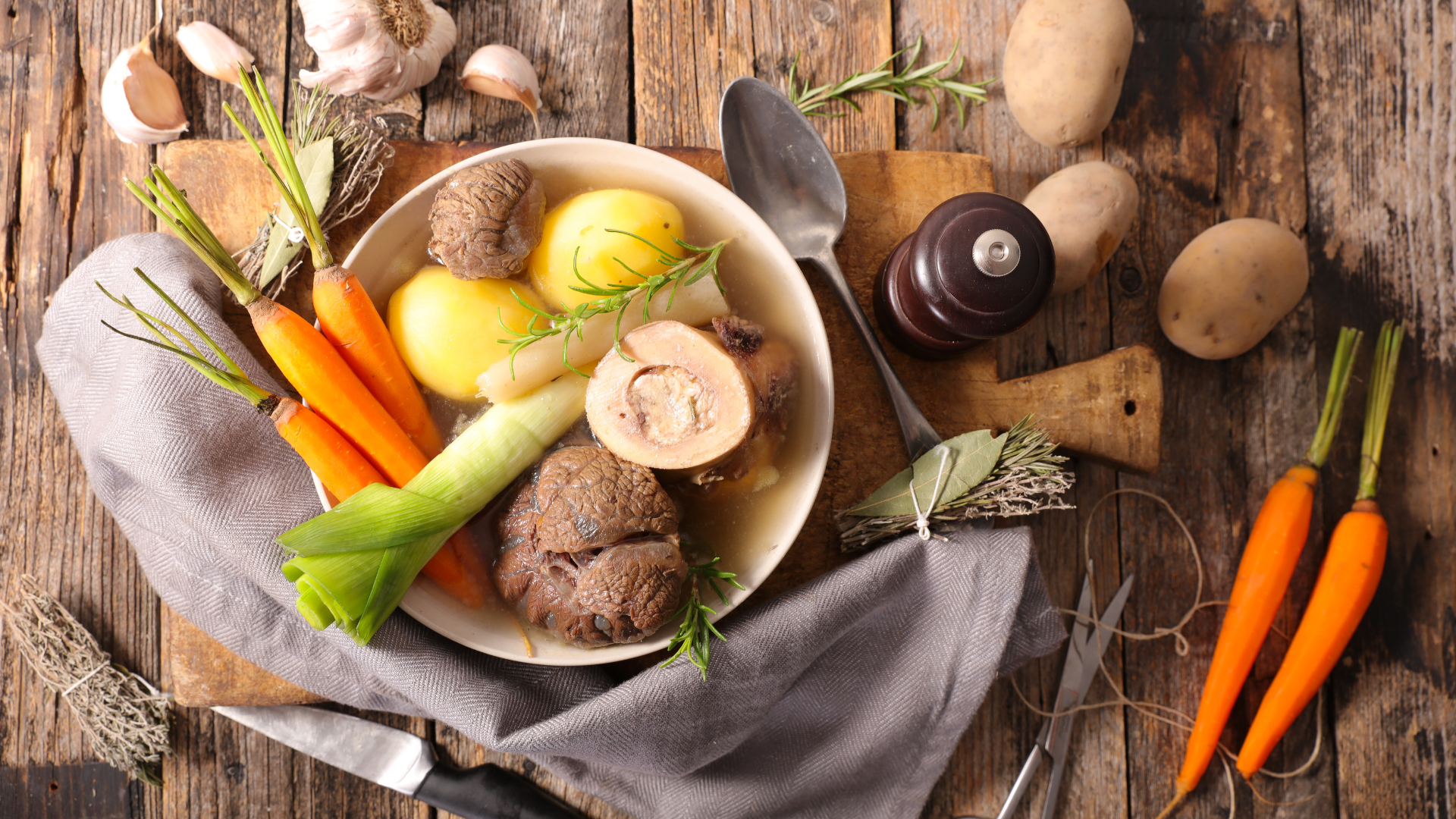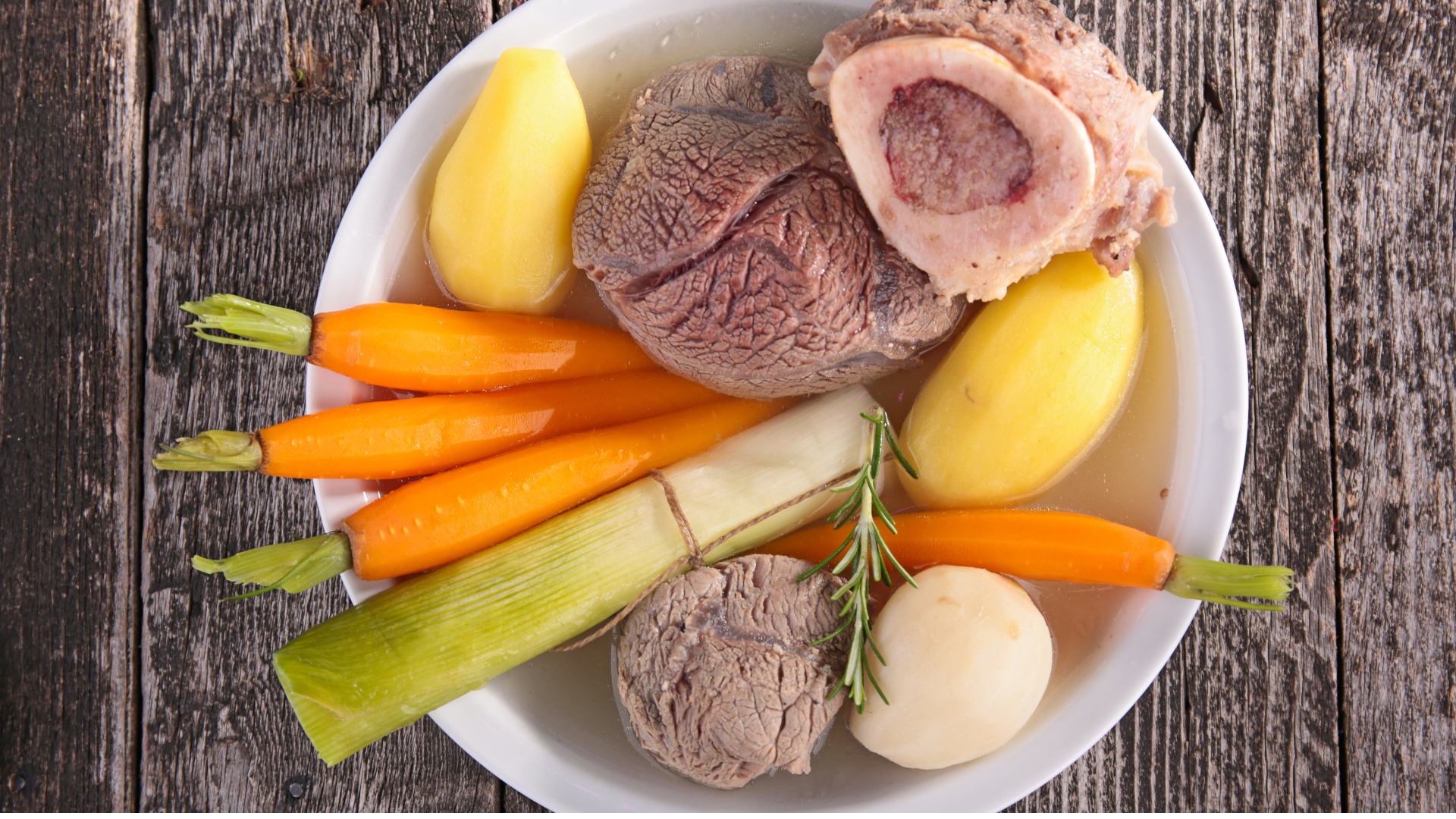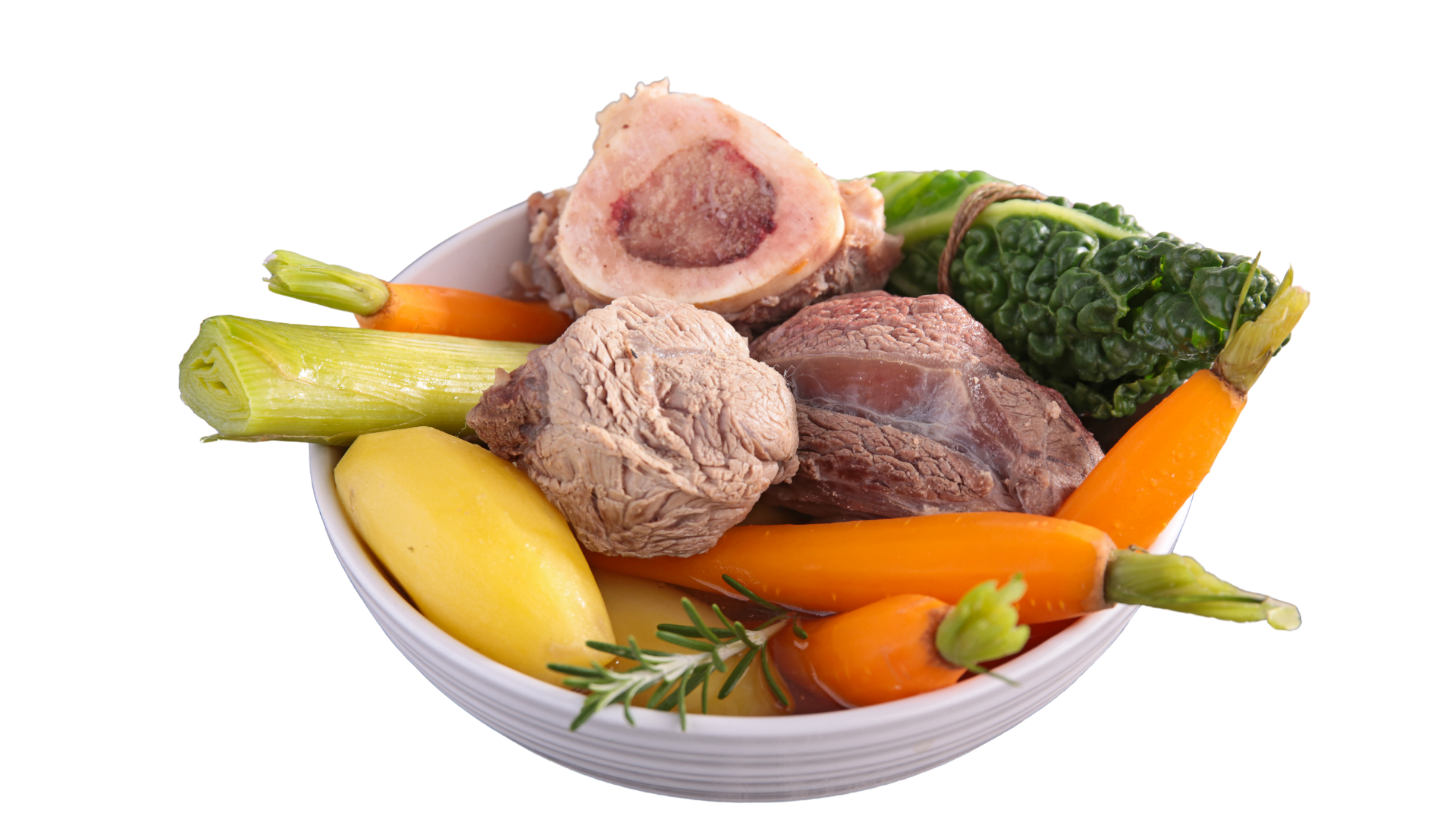Pot-au-Feu
Pot-au-Feu is one of the most traditional and beloved dishes in French cuisine, known as the quintessential French comfort food. It translates to "pot on the fire," reflecting the dish's simplicity and rustic origins. Pot-au-Feu is essentially a boiled beef stew made with a variety of vegetables, and it has been a staple of French family meals for centuries, embodying the country’s culinary philosophy of using humble ingredients to create something deeply nourishing and flavorful.
History of Pot-au-Feu
Medieval Roots:
Pot-au-Feu has deep historical roots, dating back to medieval France when cooking methods were often based on practicality and sustainability. In its most basic form, the dish is a slow-simmered one-pot meal. Similar preparations were common across Europe, where families would simmer tough cuts of meat and available vegetables in large cauldrons over a fire. These long-simmered stews were economical, allowing families to use cheaper cuts of meat while extracting maximum flavor.
16th Century Popularity:
By the 16th century, Pot-au-Feu began to be recognized as a specific dish in France, though its exact origins are difficult to pinpoint. It is widely considered a dish for the peasantry due to its reliance on readily available, inexpensive ingredients such as beef, root vegetables, and herbs. Unlike the more elaborate dishes of French nobility, Pot-au-Feu was simple and hearty, designed to feed large families in rural communities. The broth created from the simmering meat and vegetables was served as the first course, followed by the meat and vegetables for the second.
17th Century: Henry IV and Pot-au-Feu:
Pot-au-Feu became more deeply associated with French culture in the 17th century when King Henry IV of France (1553–1610) famously declared his desire that every family in his kingdom should be able to afford "a chicken in the pot" each Sunday. This expression reflects the French reverence for simple, hearty meals like Pot-au-Feu, which could sustain families and use inexpensive ingredients. While Pot-au-Feu traditionally relies on beef, Henry IV's quote symbolized the importance of nourishing meals for all French citizens, and his wish helped enshrine the dish in French culinary identity.
19th Century and Beyond:
By the 19th century, Pot-au-Feu had transcended its peasant origins and become a symbol of French national cuisine, celebrated by writers such as Alexandre Dumas, who included a recipe for Pot-au-Feu in his Grand Dictionnaire de Cuisine. The dish was praised for its ability to extract flavors from tough cuts of beef and transform simple ingredients into a meal fit for any table.
In French homes, Pot-au-Feu became a Sunday tradition, a meal shared by the family at the end of the week. Its versatility allowed for many variations across different regions of France, with some adding marrow bones, while others included more vegetables like turnips or leeks.


-
Ingredients:
1 kg (2.2 lbs) beef brisket, chuck, or shank (bone-in cuts for more flavor)
1 marrow bone (optional, for added richness)
2 large carrots (peeled and cut into large chunks)
3 leeks (white part only, trimmed and washed)
3 large potatoes (peeled and halved)
2 turnips (peeled and quartered)
1 onion (peeled and studded with 2 cloves)
3 cloves garlic (peeled)
2 celery stalks (cut into chunks)
1 bouquet garni (a bundle of thyme, parsley, and bay leaf tied together)
Salt and freshly ground black pepper
10 whole black peppercorns
Water (enough to cover the ingredients, about 3 liters)
Coarse sea salt (for seasoning the broth)
Dijon mustard and cornichons (optional, for serving)
Rustic bread (for serving)
Instructions:
Prepare the beef and start simmering:
Place the beef and marrow bone (if using) in a large pot or Dutch oven. Cover the meat with cold water (about 3 liters), and bring it to a gentle boil. Skim off any foam or impurities that rise to the surface.
Add the aromatics:
Once the foam is removed, add the onion (with cloves), garlic, bouquet garni, and peppercorns. Reduce the heat to a gentle simmer. Cover the pot and cook the meat slowly for about 2 hours.
Add the vegetables:
After the beef has been simmering for 2 hours, add the carrots, leeks, turnips, celery, and potatoes to the pot. If necessary, add more water to ensure everything is covered. Season with salt.
Continue simmering gently for another 45–60 minutes until the vegetables are tender and the meat is cooked through.
Serve the broth:
Once everything is cooked, remove the beef and vegetables from the pot, and strain the broth. Taste the broth and adjust the seasoning with salt as needed.
Serve the clear broth as a first course, optionally garnished with fresh herbs like parsley.
Serve the meat and vegetables:
Slice the meat and arrange it on a platter with the vegetables. You can also serve the marrow bone separately for those who enjoy it.
Serve the meat and vegetables as the main course, accompanied by Dijon mustard, cornichons (pickles), and rustic bread on the side.
Optional accompaniment:
Some enjoy the broth and the main course together in the same bowl, while others prefer to serve them separately. If desired, spoon some broth over the meat and vegetables for extra moisture.
Leftovers:
Pot-au-Feu is often even better the next day, as the flavors continue to meld. Leftovers can be reheated gently, and the broth can be used as a base for other soups or dishes.
Cultural Significance of Pot-au-Feu
Pot-au-Feu is more than just a dish; it is a symbol of French culinary heritage. It has come to represent the values of home-cooked meals, family gatherings, and the art of slow cooking. Its simplicity showcases the French tradition of elevating humble ingredients through technique and patience.
A Reflection of French Identity:
In France, Pot-au-Feu is seen as a national dish, much like roast beef in England or pasta in Italy. It is celebrated for being both hearty and delicate—while it uses inexpensive cuts of meat and common vegetables, the slow-cooking method extracts profound flavors and creates a meal that feels both rustic and refined.
Regional Variations:
While the classic Pot-au-Feu recipe remains largely unchanged across France, some regional variations exist. For example:
Alsace: This region might include sauerkraut alongside the beef and vegetables.
Burgundy: In this wine-producing region, some cooks add a splash of red wine to the broth.
Provence: A Mediterranean twist may include garlic and herbs de Provence for additional flavor.
Pot-au-Feu remains a beloved staple in French homes, treasured for its simplicity and depth of flavor. It is a dish that brings people together around the table, providing not just nourishment but a sense of tradition and family. Whether served in a rural farmhouse or a Parisian bistro, Pot-au-Feu is a comforting reminder of the enduring appeal of slow-cooked, hearty meals that warm both the body and the soul.


